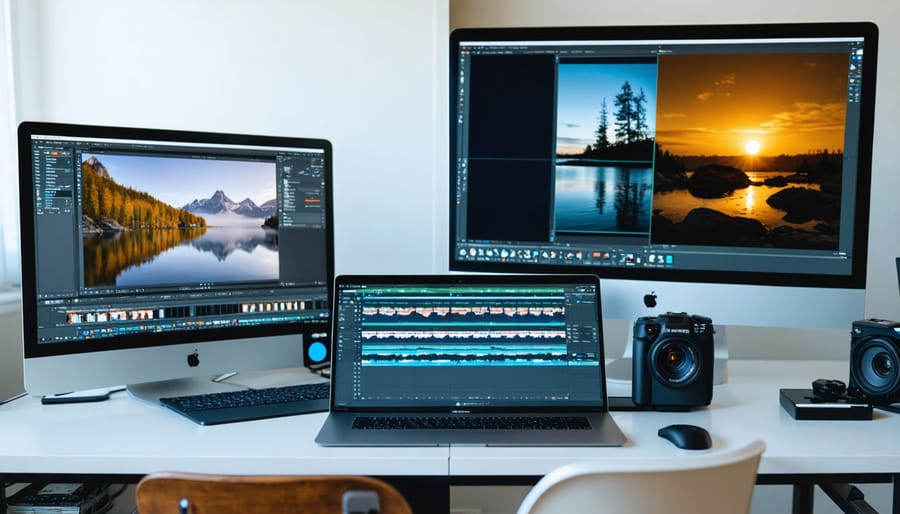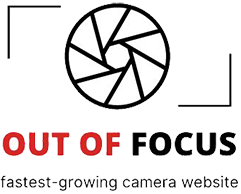
Video editing transforms raw footage into compelling stories, blending technical precision with creative artistry. In today’s digital landscape, post-production has become the cornerstone of professional content creation, whether you’re crafting viral social media clips or producing feature-length films.
Modern editing goes far beyond simple cuts and transitions. It encompasses color grading, sound design, motion graphics, and visual effects – each element working in harmony to create immersive viewing experiences. From Hollywood blockbusters to YouTube vlogs, the quality of post-production often determines a project’s success.
The evolution of editing software has democratized the craft, putting professional-grade tools in the hands of creators worldwide. DaVinci Resolve, Adobe Premiere Pro, and Final Cut Pro have become powerful creative platforms, enabling editors to realize their artistic visions with unprecedented control and flexibility.
Yet mastering video editing requires more than just technical knowledge. It demands an understanding of storytelling principles, visual rhythm, and audience psychology. The best editors know when to make bold creative choices and when subtlety serves the story better. Whether you’re just starting your editing journey or refining your professional workflow, the fundamentals of thoughtful post-production remain essential to creating content that resonates and engages.
The Fine Line Between Enhancement and Deception
Acceptable Post-Processing Techniques
While post-processing is essential in modern video production, certain techniques are widely accepted as standard practice without compromising the integrity of your footage. Color correction and grading are fundamental adjustments that help achieve consistent look and mood across scenes. Basic exposure corrections, white balance adjustments, and contrast enhancement are all considered standard practice.
Audio enhancement techniques like noise reduction, EQ adjustment, and volume normalization are crucial for professional results. Cutting and transitioning between clips, including cross-dissolves, straight cuts, and basic wipes, form the backbone of acceptable editing techniques.
Stabilization is another widely accepted practice, especially when dealing with handheld footage. Light motion tracking and basic visual effects like speed ramping can enhance storytelling without crossing ethical boundaries. Adding titles, lower thirds, and basic graphics is standard practice across all genres of video production.
Advanced techniques like skin smoothing and blemish removal are acceptable when used subtly and primarily for interview subjects or promotional content. However, it’s crucial to maintain natural-looking results. Basic compositing, like adding a sky replacement or removing distracting elements, is acceptable when done transparently and serves the story’s purpose.
Remember that the goal is to enhance your footage while maintaining authenticity and credibility. These techniques should support your narrative rather than fundamentally alter reality.

When Enhancement Becomes Manipulation
While photo enhancement has become a standard practice in digital photography, there’s a fine line between improvement and manipulation. When editors begin crossing ethical boundaries, they risk compromising the integrity of their work and misleading their audience.
Consider the difference between adjusting exposure to reveal detail in shadows versus completely replacing a cloudy sky with a dramatic sunset from another photo. While the first example enhances what was actually captured, the second creates a false reality. This becomes particularly problematic in photojournalism, documentary work, or when presenting images as authentic representations of events or products.
Common red flags include excessive skin smoothing that eliminates natural texture, dramatic body reshaping that promotes unrealistic standards, or composite images presented as single captures without disclosure. These practices can contribute to unrealistic expectations and erode trust in photography as a medium.
The key is maintaining transparency with your audience. If you’re creating artistic composites or heavy manipulations, label them as such. For commercial work, ensure your edits align with advertising standards and regulations. Remember, enhancement should serve to present the subject in its best light while preserving its essential truth.
Ethical Guidelines for Photo Editing
Transparency with Clients
Maintaining open communication with clients about your editing process is crucial for building trust and ensuring satisfaction with the final product. Start by setting clear expectations during the initial consultation, discussing the client’s vision, and explaining your editing approach. Be specific about what can and cannot be achieved through post-production to avoid unrealistic expectations.
Throughout the editing process, keep clients informed about significant creative decisions. When making substantial changes to footage, such as color grading or special effects, consider sharing before-and-after comparisons or work-in-progress previews. This allows clients to provide timely feedback and helps prevent major revisions later.
Document your editing decisions and maintain detailed notes about specific requests or changes. When presenting drafts, explain your creative choices and how they align with the project’s goals. For instance, if you’ve adjusted the pacing of a sequence or enhanced certain visual elements, share your reasoning behind these decisions.
Be honest about technical limitations or challenges that arise during post-production. If a particular effect or transition isn’t achievable within the project’s scope or budget, propose alternative solutions that can still meet the client’s objectives. This proactive approach demonstrates professionalism and helps maintain a positive working relationship.
Remember to establish clear revision policies and communicate them upfront. Specify how many rounds of revisions are included in your service and what additional changes might incur extra costs. This transparency helps prevent scope creep and ensures both parties have aligned expectations throughout the project.
Documenting Your Process
Keeping detailed records of your video editing process isn’t just good practice – it’s essential for maintaining a professional workflow and protecting your work. Start by creating a systematic file naming convention that includes the project name, date, and version number (e.g., “ProjectName_20240215_V1”). This simple step can save hours of confusion later.
Organize your projects into a clear folder structure. Create separate folders for raw footage, audio files, graphics, and exports. Within each project, maintain a version history folder to store different iterations of your edit. This prevents accidental overwrites and allows you to backtrack if needed.
Consider keeping an editing log or project notes document. Record key decisions, client feedback, and technical specifications like export settings. Note any special effects or transitions used, along with their specific parameters. This documentation becomes invaluable when revisiting projects months later or when collaborating with other editors.
Always preserve your original files. Store them on a separate drive or cloud backup system, and never modify them directly. Work with copies in your editing timeline, and keep your project files separate from the raw footage. This approach ensures you can always start fresh if needed.
For complex projects, create a shot list or edit decision list (EDL) that tracks the placement and timing of each clip. This helps maintain consistency across versions and simplifies client revisions.

Industry Standards and Professional Codes
The video editing and post-production industry operates under well-established guidelines that protect both creators and viewers. Understanding these photography ethics fundamentals is crucial for maintaining integrity in your work.
Most professional organizations adhere to specific standards regarding image manipulation, color correction, and content authenticity. These professional ethical standards typically include guidelines about disclosing significant alterations, maintaining original files, and respecting copyright laws.
Key industry standards include:
– Preserving the essential truth of the captured moment
– Maintaining accurate metadata and documentation
– Following proper archival practices
– Adhering to client specifications and industry-specific requirements
– Respecting intellectual property rights
Professional organizations like the American Society of Media Photographers (ASMP) and Professional Photographers of America (PPA) provide comprehensive ethical guidelines for their members. These guidelines often address issues such as:
– Acceptable levels of image manipulation
– Proper crediting and attribution
– Client confidentiality
– Fair pricing practices
– Quality control standards
Following these established standards not only ensures professional integrity but also helps build trust with clients and maintains the industry’s reputation for quality and authenticity.
Real-World Applications
Portrait Photography Ethics
Portrait editing requires a delicate balance between enhancement and authenticity. Following proper ethical portrait photography guidelines is crucial for maintaining trust with clients and preserving the integrity of your work.
When editing portraits, it’s essential to communicate clearly with your subjects about the extent of retouching you plan to perform. Some clients may request dramatic changes, while others prefer minimal adjustments. Always respect their preferences while maintaining professional standards.
Consider these key ethical principles:
– Preserve natural features that make your subject unique
– Avoid dramatic alterations that change someone’s identity
– Be transparent about your editing process
– Keep original files for reference
– Obtain explicit consent for specific retouching requests
Temporary blemishes and distracting elements can typically be removed without ethical concerns. However, permanent features like birthmarks, scars, or body shape should be approached with sensitivity and discussed beforehand. Remember that your editing choices can impact your subject’s self-image and society’s beauty standards.
For commercial work, industry standards often require disclaimers for heavily edited images, particularly in advertising. Many countries now mandate disclosure of significant digital alterations in commercial photography.
The goal of portrait editing should be to enhance, not transform. Think of it as polishing a gemstone rather than creating an entirely different stone. This approach helps maintain authenticity while still delivering professional results that both you and your clients can be proud of.

Photojournalism and Documentary Work
When it comes to news and documentary photography, ethical considerations take center stage in the editing process. Understanding and following ethical principles in photojournalism is crucial for maintaining integrity and public trust.
The golden rule in photojournalistic editing is simple: maintain the truth of the captured moment. Unlike creative photography, where artistic manipulation is welcomed, documentary work demands strict adherence to reality. Basic adjustments like exposure correction, white balance, and minimal cropping are generally acceptable, but any manipulation that alters the fundamental truth of an image is strictly forbidden.
Here are the key guidelines to follow:
– Never add or remove elements from the photograph
– Avoid excessive color manipulation that might change the viewer’s perception
– Use cropping only to improve composition, not to exclude important context
– Maintain original metadata and be prepared to provide RAW files if requested
– Document all editing steps for transparency
When working with documentary images, it’s essential to develop a consistent workflow that preserves the authenticity of your captures. Many news organizations have specific guidelines about acceptable adjustments, typically limiting them to:
– Basic exposure corrections within reasonable limits
– Lens distortion corrections
– Dust spot removal (only for sensor dust)
– Minor adjustments to contrast and clarity
– Basic sharpening for print or web output
Remember that your role as a photojournalist is to document reality, not enhance it. When in doubt, err on the side of minimal editing. The goal is to present images that accurately represent the events and scenes you’ve captured, maintaining the public’s trust in visual journalism while ensuring your work remains a reliable historical record.

Commercial Photography Considerations
In commercial photography, striking the perfect balance between client expectations and ethical editing practices is crucial for maintaining professional integrity. While clients often request specific enhancements or alterations, it’s essential to establish clear boundaries and communicate openly about what constitutes acceptable post-production practices.
Start by setting realistic expectations during the initial client consultation. Discuss your editing approach and limitations upfront, particularly regarding extensive retouching or manipulative editing. This transparency helps prevent misunderstandings and establishes trust with your clients.
Consider implementing a standard editing policy that outlines your approach to common requests:
– Basic adjustments (exposure, contrast, color correction)
– Skin retouching (temporary blemish removal, subtle smoothing)
– Environmental touch-ups (removing distracting elements)
– Product enhancement (color accuracy, detail preservation)
When faced with challenging requests, remember that your reputation depends on maintaining ethical standards. If a client asks for dramatic alterations that might mislead consumers or violate industry standards, be prepared to explain why certain changes could be problematic. For instance, excessive body modification in fashion photography or unrealistic product representation in advertising can lead to legal issues and damage your credibility.
Document your editing process and maintain before-and-after versions of your work. This practice not only protects you professionally but also helps demonstrate the value of your post-production services to clients. Consider creating a portfolio that showcases tasteful, ethical editing to set appropriate client expectations.
Industry best practices suggest:
– Preserving the authentic essence of the subject
– Making adjustments that enhance rather than fundamentally alter
– Ensuring consistency across campaign images
– Maintaining accurate product representation
Remember that building long-term client relationships often depends on finding the sweet spot between meeting commercial objectives and upholding professional integrity. When in doubt, err on the side of authenticity – satisfied clients will appreciate your commitment to honest representation and quality work.
As we’ve explored throughout this article, video editing and post-production are powerful tools that can transform raw footage into compelling stories. However, with this power comes significant responsibility. The key is striking the right balance between creative enhancement and maintaining authenticity.
Remember that ethical editing practices aren’t just about following rules – they’re about respecting your audience and preserving the integrity of your work. Whether you’re color grading a documentary or adding special effects to a commercial project, transparency about your editing choices helps build trust with your viewers.
The industry continues to evolve with new technologies and techniques, but certain principles remain constant: represent your subjects truthfully, maintain clear communication with clients about editing decisions, and always preserve original footage. These foundations ensure that your creative vision doesn’t compromise professional standards.
As you develop your editing skills, focus on enhancing rather than fabricating. Use transitions, effects, and color correction to support your narrative, not to mislead. Consider each edit’s impact on the final message and whether it serves the project’s purpose.
Looking ahead, the future of video editing will likely bring even more powerful tools and capabilities. By establishing strong ethical practices now, you’ll be better positioned to navigate these advances while maintaining professional integrity. Remember, the most impactful edits are often those that enhance the truth rather than distort it.






















